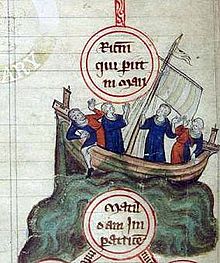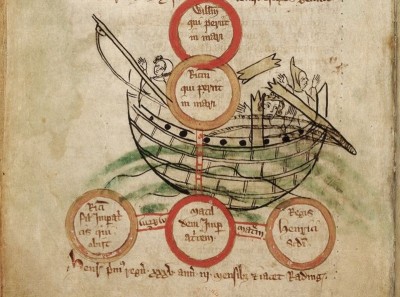It´s not known when Guthrum was born, or how he acquired the power necessary to lead the Vikings  under the Danelaw, but it is fairly certain that he arrived in England with the great Viking invasion in 865, and it´s absolutely certain that he gave Alfred the Great a run for his crown.
under the Danelaw, but it is fairly certain that he arrived in England with the great Viking invasion in 865, and it´s absolutely certain that he gave Alfred the Great a run for his crown.
This invasion force came to be known as The Great Heathen Army in the Anglo-Saxon Chronicle of that same year, and was a consolidation of Viking warriors, probably mainly from Denmark, but also from Norway and Sweden, and was quite different from the previous “hit and run”-attacks on England performed by Vikings in that it lasted for 14 years.
Ten years later, in 875, the Great Heathen Army split into two, with one part being led further north while the other part, under the command of Guthrum set up base in East Anglia, from where he only a year later had acquired parts of Mercia and Northumbria, with his sight set on Wessex, ruled by Alfred the Great with the first confrontation between them as a result.
Sailing around Poole Harbour and linking up with another Viking army which was invading the area between the Frome and Piddle rivers, he defeated Alfred this first time, taking the castellum and the ancient square earthworks known as the Wareham.
A peace settlement brokered by Alfred didn´t last long, because in 877 Guthrum´s army moved further into Wessex, with a series of confrontations between the two as a result, all won by Guthrum and his forces.
 The beginning of the end came on Epiphany, January 6, 878 Guthrum´s army launched a surprise attack on Alfred and his court at Chippenham in the middle of the night. To avoid capture Alfred fled into the marshes of Somerset with only a few retainers. Building up his forces over the months to come, he fought a guerilla war against the Vikings until the two forces eventually met for the Battle of Eddington in May 878.
The beginning of the end came on Epiphany, January 6, 878 Guthrum´s army launched a surprise attack on Alfred and his court at Chippenham in the middle of the night. To avoid capture Alfred fled into the marshes of Somerset with only a few retainers. Building up his forces over the months to come, he fought a guerilla war against the Vikings until the two forces eventually met for the Battle of Eddington in May 878.
It´s not known how great the respective forces were, or how many that died on either side, it seems Guthrum´s forces may have been weakened by internal disputes as well as the loss of 120 ships in a storm in 876-77. After the battle, which Alfred eventually won, the remaining Viking forces fled to a fortress where they were besieged for two weeks before giving up due to lack of food.
Guthrum negotiated the Treaty of Wedmore with Alfred, in which he agreed to be baptised as a Christian, adopting the name of Aethelstan and accepting Alfred as his Godfather. Guthrum respected the treaty for the remainder of his life, withdrawing his forces from the western borders of Wessex and retreated to the Kingdom of Guthrum in East Anglia where he died at an unknown age in 890. He was buried at Headleage, which is usually identified as Hadleigh in Suffolk.
The Danelaw, as mentioned in Anglo-Saxon Chronicle, is the historical name of the part of England where the laws of the Danes, or Vikings, held sway over the Anglo-Saxon laws. While the name first came to describe the legal terms in the treaties drawn up between Alfred and Guthrum and formalised in 886, defining the boarders of their respective kingdoms as well as providing provisions for relations between the English and the Vikings.
where the laws of the Danes, or Vikings, held sway over the Anglo-Saxon laws. While the name first came to describe the legal terms in the treaties drawn up between Alfred and Guthrum and formalised in 886, defining the boarders of their respective kingdoms as well as providing provisions for relations between the English and the Vikings.
The term was first recorded in the early 11th century as Dena Lage. While first only describing the legal terms, it has come to include the area which was ruled under the Danelaw, compromising 14 shires: York, Nottingham, Derby, Lincoln, Essex, Cambridge, Suffolk, Norfolk, Northampton, Huntingdon, Bedford, Hertford, Middlesex and Buckingham.
Sources:
From Alfred the Great to Stephen – R.H.C Davis
Anglo Saxon Chronicle Trans. by M. J. Swanton
Scandinavian Britain – F.Y Powell, M.A. Collingwood
The Northern Conquest: Vikings in Britain and Ireland – K. Holman
Map by Hel-hama/Wikimedia Commons
Map of The Great Heathen Army´s movement – The History Podcast



